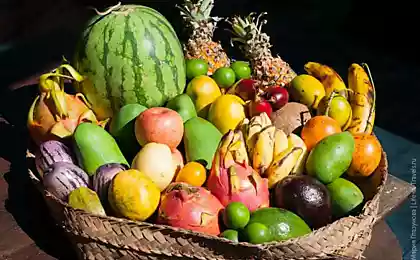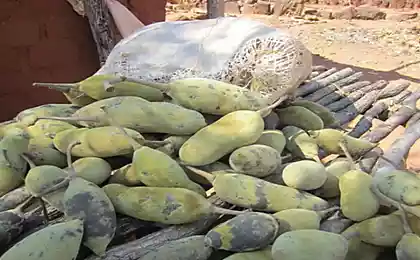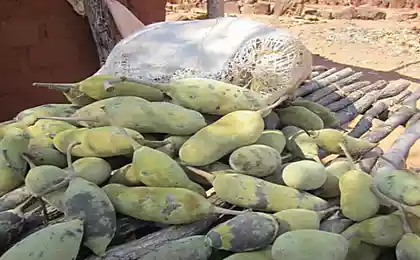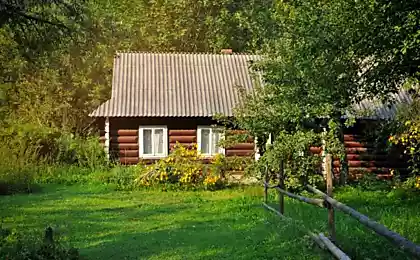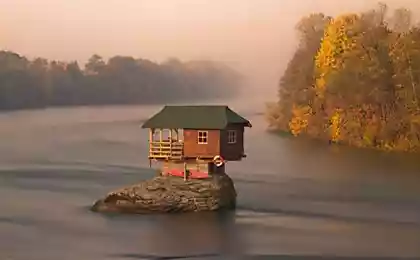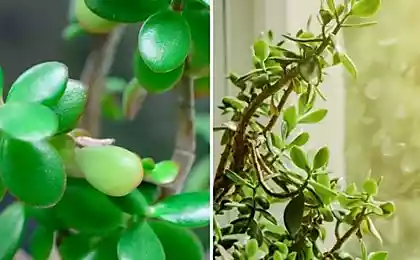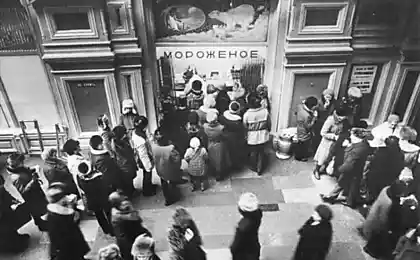747
Tamarillo — tree tomato

Tsifomandra or Tomato tree — a South American plant, belongs to the family Solanaceae. This is a shrub or small tree with large, velvety heart-shaped leaves and white-pink flowers similar to potato. Tsifomandra not only beautiful but also useful: after flowering it in abundance formed a reddish-orange ovoid fruits resembling tomatoes. The taste of these fruits of a kind with a distinct tart flavor. Actually, for the sake of these fruits and grow this beautiful and powerful kadochnoe plant. Tomato tree very easy to grow from seed. In this case it will flower in the second year .
Small, attractive, evergreen, fast-growing, brittle tree; reaches 3-5.5 m in height (rarely up to 7.5 m) the Root system is shallow. The leaves are fragrant, heart-shaped at the base, oval, pointed at top, thin, slightly hairy, 10-35 cm long and 4-12 cm wide. Located in small groups of fragrant flowers with a diameter of 1.25-2 cm, have 5 pale-pink or lavender, pointed petals, and 5 protruding yellow stamens and purplish-green calyx. Smooth fruit egg-shaped, arranged singly or in groups of 3-12 on long stalks. The fruit can be from 5 to 10 cm long and 4-5 cm wide. The color of the skin — a thick dark purple, blood red, orange or yellow, sometimes with faint dark longitudinal stripes. The color of the pulp from orange-red to orange or yellow and cream yellow. While the skin is tough and malosedobnaya — the outer part of the flesh is dense, juicy and fresh, and the interior surrounding the seeds is soft, juicy, sweet or sour-sweet taste; it is black in dark purple and red fruits and yellow in yellow and orange fruits. The seeds are thin, nearly flat, circular, larger and harder than the tomato seeds and have a bitter taste. The fruit has a slightly resinous aroma and flavor, reminiscent of a not ripe tomato with a light resinous taste.
Origin and distribution.
Home is the Andes of Peru, Chile, Ecuador and Bolivia, where it is widely distributed, as well as in Argentina, Brazil and Colombia. Cultivated and naturalized in Venezuela. Grown in the mountains of Costa Rica, Guatemala, Jamaica, Puerto Rico and Haiti. Tomato tree very early came to East Africa, Asia and India, and Australia.
Often touted as an interesting plant for growing in pots indoors. In the Northern regions can be successfully cultivated in greenhouses.
Tomato tree is a plant of subtropical climate. Best possible where the temperature does not fall below 10° C. Freezing at -2° C kill young branches and foliage of Mature trees. A tree can recover if this low temperature is not held for a long time. However, seedlings and young plants in the age of 1 year is easily killed by frost. The tree has a superficial root system and is therefore unstable in a strong wind. Wood tomato tree is very brittle and branches break easily in the wind, especially when Laden with fruit yield.
Soil.
The tree tomato does not tolerate dense land with low oxygen content. The best is a lightweight, fertile land. Good drainage is essential. Water stagnation for a few days can cause the plants to die.
Reproduction.
For reproduction you can use seeds or cuttings. From the seed grows a straight tree with branches high above, plants grown from cuttings are transformed into a lower, bushy plant with low lying branches, suitable for exposed, windy sites. The plant does not always reproduce its qualities when grown from seed, but seeds taken from a red fruit with black pulp or yellow fruits with yellow flesh usually keeps the quality of the parent plants.
Seeds for planting are first washed, dried in the shade, and then placed in the fridge for 24 hours to accelerate germination. They are then planted in boxes of rich soil with a distance of 60 cm.
Seeds for planting are first washed, dried in the shade, and then placed in the fridge for 24 hours to accelerate germination. They are then planted in boxes of rich soil with a spacing of 60 cm between rows and 30 cm between plants in the row. Usually after 4-6 days grows 100% of the seeds.
Trees grown from seed are pruned one year after the first fruiting at a height of 0.9-1.2 m to improve development of branches. Annually need to trim already otplodonosivshih branches, thereby causing the growth of new shoots, since fruits are produced on new growth. If this is not done, the tree forms a broad crown with fruits only on its outer surface. Pruning in early spring causes early ripening; the autumn pruning delays ripening until next fall.
The tree tomato cannot tolerate prolonged desiccation of the soil should have enough water for its development, especially in dry periods.
The tree typically begins to bear fruit at the age of 1.5-2 years is considered to be productive for 5-6 years. If the plant gets enough food, it can continue to bear fruit up to 11-12 years
The fruits ripen at the same time, so it takes a few collection cycles. The fruits are cut from the stalk about 1 cm.
The tree tomato is generally considered quite pest resistant.
Tomato tree is known for its resistance to tobacco mosaic virus, although it is susceptible to cucumber mosaic virus and potato virus.
Use.
Tamaricaceae the fruits of the tomato tree are cut lengthwise into two parts and used with sugar or flavored with fried or baked for 15 minutes and used as vegetables. When cutting the fruit, we must remember that the juice leaves a stubborn spot. For other purposes, the skin must be removed — this is easy to do if you pour the fruit of boiling water and leave them for 4 minutes, then peel is easily removed. The peeled fruit can be cut into slices and used for sautéing or in soups or consumed with sugar or with vanilla ice cream. Seasoned with salt and pepper, slices can be used in sandwiches or in salads. Chopped slices are blended with cream cheese. Peeled, sliced fruits, chopped onion, bread crumbs, butter and appropriate seasonings are used as a garnish for roast lamb. Cut the slices of fruits, alone or in a mixture of chopped apples, used as a filling for pies.
The fruit can be used for canning. Puree is derived from peeled fruit using a mixer or by means of ratmate cooked fruits and subsequent filtering out seeds Packed in plastic containers and frozen. In the puree you can add lemon juice. Peeled stewed fruit mixed with gelatin, milk, sugar and lemon juice to prepare the dessert, which is then decorated with slices of fresh fruit. Of peeled and cut fruit with lemon peel and lemon juice made jam. In mixture with onions and apples made chutney. Due to the high content of pectin, is easily obtained from the fruit jelly, but without special processing during the preparation of the fruit is oxidized and discolored. Tamarillo is a very useful and nutritious fruit. It has large amounts of vitamins A, B6, C and E, iron, potassium, and no cholesterol and sodium. Especially recommend it to anyone who suffers from frequent migraines.
When buying tamarillo choose fruit with a bright even color and tight-fitting stem. In quality the fruits should not be any stains, dents and other defects. At pressing the flesh slightly bends under your finger, but quickly recovers its original shape.
Source: /users/1077
